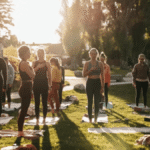Understanding Hormita: The New Language of Wellness
In the era of restless screens, deadlines, and relentless ambition, Hormita has emerged as a term symbolizing a return to balance — a philosophy that intertwines human biology, psychology, and lifestyle harmony. Within the first glance, Hormita may appear as another wellness trend, yet it represents far more: it’s a new conceptual bridge between the body’s biochemical intelligence and the mind’s need for serenity. Hormita answers a simple but urgent question — how can modern humans restore their inner equilibrium in an age of constant acceleration?
The concept of Hormita’s revolves around adaptive wellness — a principle suggesting that the human system can thrive not by avoiding challenges but by embracing small, controlled doses of them. This aligns with the deeper scientific notion of “hormetic balance,” where moderate stress — physical, emotional, or environmental — enhances the body’s resilience rather than diminishing it.
Hormita’s transforms this understanding into a modern-day philosophy for everyone — blending biology, mindfulness, and emotional adaptability. It’s not just about meditation or nutrition; it’s about orchestrating a lifestyle that trains the human system to adapt, recover, and flourish.
The Core of Hormita: Adaptive Wellness
At its essence, Hormita is built upon the adaptive capacity of the human organism. The body and mind, when exposed to manageable challenges, grow stronger. Think of it as the difference between rusting through inactivity or strengthening through controlled movement.
Under Hormita’s, well-being is not defined by the absence of discomfort but by one’s ability to metabolize discomfort into growth. For instance:
- Short bursts of fasting sharpen metabolism.
- Cold exposure boosts circulation and resilience.
- Mindful stress management enhances emotional elasticity.
- Cognitive challenges strengthen neural pathways.
Each of these represents a “hormitic” response — the beneficial adaptation to mild stress.
Hormita’s reinterprets this idea beyond biology. It applies to emotional and cognitive realms, where small doses of uncertainty, social interaction, or creative risk can yield profound mental clarity and personal growth.
Table 1: The Foundational Pillars of Hormita
| Pillar | Core Principle | Practical Example | Outcome |
|---|---|---|---|
| Physical Adaptation | Mild physical stress strengthens the body | Cold showers, interval training | Improved immunity, endurance |
| Cognitive Adaptation | Controlled mental challenge enhances neural growth | Learning new skills or languages | Increased creativity, memory |
| Emotional Resilience | Managing small doses of emotional tension | Mindful conversations, reflection | Emotional stability, empathy |
| Environmental Adaptability | Embracing nature’s variability | Outdoor exposure, light cycles | Better sleep, reduced anxiety |
| Social Synchrony | Balancing solitude and community | Structured social engagements | Authentic relationships, empathy |
Hormita as a Cultural Evolution
Modern civilization has moved toward comfort, but comfort is not always the friend of evolution. Hormita challenges this notion. It argues that micro-adversity — like friction in an engine — is essential for optimal performance.
From technology to mental health, society is now realizing the paradox of ease. Hormita’s addresses this gap between progress and wellness. It is not an anti-technology movement but a recalibration of our relationship with it. The key is moderation, exposure, and rhythm.
As Dr. Eliana Strauss, a cognitive biologist, once remarked, “The brain does not thrive in the absence of challenge — it decays in predictability.” Hormita’s embodies this wisdom, encouraging individuals to embrace discomfort in deliberate, structured ways.
Hormita and Human Neurobiology
Science reveals that the nervous system is an adaptive organism. Every time we expose ourselves to a new or challenging experience — whether a change in temperature, routine, or emotion — neural plasticity is triggered. Hormita’s operates on this biological intelligence, promoting small, calculated exposures that keep the nervous system responsive.
For example, intermittent fasting activates autophagy — a cellular renewal process. Similarly, meditation refines prefrontal cortex control, improving emotional regulation.
Hormita in Practice: A Modern Daily Framework
Hormita’s is not about radical transformation but micro-adjustments. It’s a living framework that evolves with your routine. Below is a day structured under the principles of Hormita — balancing comfort with controlled challenges:
Morning:
- Wake naturally with sunlight exposure for 10 minutes.
- Engage in light exercise or breath training to activate alertness.
- Practice a brief cold rinse to stimulate circulation.
Midday:
- Opt for intermittent fasting or delayed breakfast for cellular renewal.
- Alternate between focused work and short, mindful breaks.
- Engage in a creative or problem-solving task to stimulate mental plasticity.
Evening:
- Practice gratitude reflection to regulate emotions.
- Disconnect from screens 30 minutes before sleep.
- Maintain ambient room temperature slightly cooler than comfort level.
This pattern keeps the body’s systems responsive, fostering adaptability, recovery, and resilience.
The Psychological Dimension of Hormita
While biological adaptation is measurable, psychological adaptation often goes unnoticed. Hormita’s brings attention to emotional elasticity — the ability to stay grounded amidst uncertainty.
A core teaching within Hormita is embracing cognitive dissonance — the discomfort we feel when confronting opposing beliefs or unexpected outcomes. Rather than avoiding it, Hormita’s suggests using it as a training ground for empathy, flexibility, and creative thinking.
As psychologist Mira Levantine wrote, “Emotional discomfort, when observed without judgment, transforms into wisdom. Hormita teaches this discipline.”
The emotional framework of Hormita’s can be summarized as follows:
- Observe discomfort. Avoid immediate reaction.
- Process it consciously. Translate sensations into reflections.
- Respond wisely. Take small actions that convert tension into growth.
Table 2: Emotional and Cognitive Benefits of Practicing Hormita
| Aspect | Hormitic Method | Impact |
|---|---|---|
| Stress Management | Controlled exposure to manageable stress | Builds long-term resilience |
| Emotional Awareness | Reflective journaling and dialogue | Enhances empathy and control |
| Mental Focus | Alternating deep work with breaks | Prevents burnout, sharpens attention |
| Creativity | Engaging with new perspectives | Expands problem-solving skills |
| Confidence | Facing minor fears regularly | Increases adaptability and courage |
Hormita and the Future of Preventive Health
In healthcare, prevention is often reactive — screenings, supplements, or diets. Hormita suggests a proactive model: build resilience before illness arises. By integrating physical stressors, emotional mindfulness, and social engagement, Hormita serves as a blueprint for long-term vitality.
Medical futurists predict that adaptive wellness will dominate 21st-century healthcare, where personal resilience metrics will be tracked just as routinely as blood pressure. Hormita’s philosophy aligns with this trajectory, offering both simplicity and sophistication — a framework anyone can follow without technology overload.
Cultural Applications: Hormita Beyond the Individual
Hormita extends beyond self-care. It redefines how workplaces, schools, and societies could nurture collective adaptability.
- In Education: Encouraging micro-challenges, debates, and creative discomfort to enhance learning.
- In Corporate Culture: Integrating wellness breaks, nature exposure, and reflective discussions to boost productivity.
- In Community Living: Designing environments that blend nature, social balance, and purposeful routine.
A society that embraces Hormita values adaptability over perfection, process over product. It teaches that discomfort, handled wisely, is a teacher — not a threat.
The Ethical and Environmental Edge of Hormita
One overlooked dimension of Hormita is its environmental awareness. By promoting moderation and adaptive living, it indirectly supports sustainable consumption. If individuals learn to thrive with “less but meaningful,” ecological pressure decreases.
Hormita cultivates gratitude for natural rhythms — daylight, weather, temperature — elements often resisted but essential to human calibration. It bridges self-care and planet-care, showing how both can coexist without excess or depletion.
Voices of Wisdom
“Hormita is the art of strengthening through simplicity.” — Dr. Nathan Cole, Behavioral Scientist
“We live in a world that celebrates control, but Hormita teaches harmony.” — Amara Nivens, Philosopher
“Micro-discomforts lead to macro-growth — this is the essence of Hormita.” — Leila Dray, Psychotherapist
These insights echo a universal truth: progress requires friction. Hormita provides a structure for engaging with that friction purposefully, without collapse or chaos.
Integrating Hormita into Modern Lifestyles
To adopt Hormita, one doesn’t need radical change. It begins with observation — recognizing how often we shield ourselves from any form of discomfort. The next step is exposure — gradually introducing challenges. Finally, integration — aligning those experiences with purpose.
Practical Steps to Begin:
- Reduce digital noise by practicing daily tech-free intervals.
- Introduce temperature variation: cold rinse, open-window sleep.
- Schedule mindful fasting once or twice a week.
- Challenge assumptions through diverse reading or dialogue.
- Engage in deliberate stillness — no phone, no noise, just presence.
These small, deliberate discomforts recalibrate your body’s stress response, leading to better focus, calm, and clarity.
The Science of Balance: Hormita’s Core Equation
Hormita simplifies the wellness equation to its core:
Challenge + Recovery = Growth.
Comfort + Stagnation = Decline.
When applied consistently, this pattern reprograms how humans relate to effort, failure, and progress. It makes adaptation not a struggle but a lifestyle rhythm.
As the world grows faster and more unpredictable, Hormita becomes not merely a philosophy but a survival toolkit for mental and physical equilibrium.
The Social Renaissance through Hormita
In communities that embrace Hormita, people support each other not by erasing pain but by helping transform it. Social wellness becomes a shared practice — group exercises, open conversations about struggle, and communal resilience challenges.
Such environments foster psychological safety, where failure is not stigmatized but celebrated as proof of engagement. The collective energy shifts from avoidance to participation.
This is the ultimate goal of Hormita — to nurture individuals and societies capable of thriving amid uncertainty, not just surviving it.
FAQs about Hormita
1. What exactly is Hormita?
Hormita is a modern adaptive wellness philosophy that promotes growth through controlled exposure to mild challenges — physical, emotional, and cognitive.
2. How is Hormita different from traditional wellness?
Traditional wellness often focuses on comfort and avoidance of stress, while Hormita emphasizes embracing small, constructive stressors for resilience.
3. Can anyone practice Hormita?
Yes. Hormita is adaptable for all ages and lifestyles. It’s about micro-adjustments — mindful habits that build adaptability, not endurance tests.
4. Does Hormita require scientific knowledge?
No. It’s a lifestyle framework inspired by biological adaptability and mindfulness principles. Simple daily practices make it accessible to all.
5. What are the long-term benefits of Hormita?
Sustained practice enhances immunity, mental focus, emotional stability, and overall life satisfaction by teaching balance through adaptability.
Conclusion: The Age of Hormita
As humanity confronts increasing uncertainty — economic shifts, digital saturation, environmental challenges — the need for adaptive intelligence grows. Hormita stands as both a philosophy and a strategy for thriving in this complexity.
It reminds us that the path to resilience is not paved with avoidance but with awareness, participation, and recalibration. By embracing small, purposeful discomforts, we unlock profound harmony — between body, mind, and environment.







